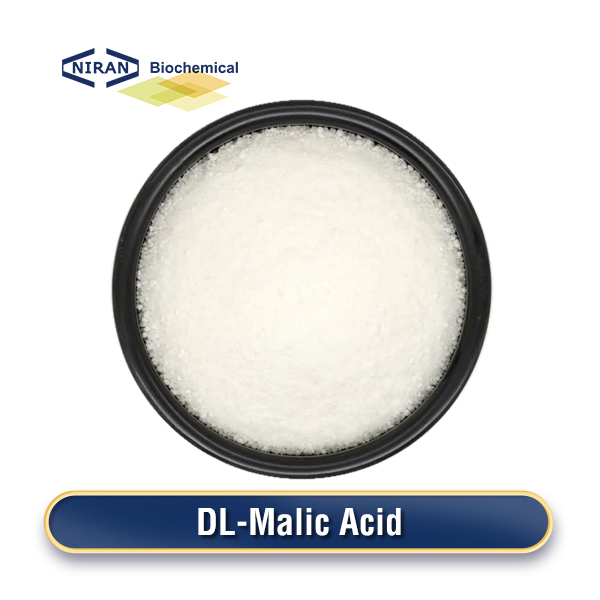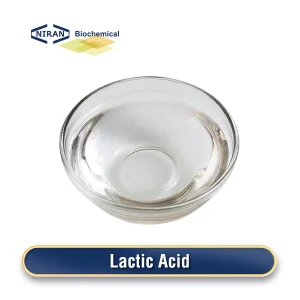What is DL-Malic Acid?
DL-malic acid presents as a white crystalline powder, typically odorless or with a faint characteristic smell. It can be used as an acidifier, color retainer, preservative, etc. in the food industry, and can also be used in pharmaceuticals; it can be used as a descaling agent, fluorescent whitening agent, etc. in industry.
When producing DL-malic acid, benzene undergoes catalytic oxidation to yield maleic acid and fumaric acid, which are subsequently hydrated under high temperature and pressure. The main reaction products are malic acid along with a minor quantity of fumaric acid. The fumaric acid crystals are isolated via filtration, while the remaining solution is concentrated and solids are separated through centrifugation to obtain crude malic acid. This crude product is further purified and crystallized to obtain the final product.
It is also possible to catalyze fumaric acid or maleic acid with water under high temperature and high pressure to obtain DL-malic acid, or to use fermentation to produce L-malic acid by fermenting fumaric acid with biological enzymes.
Related parameters:
| Testing Item | Standard | |
| Sensory Requirement | Colour and Lustre | White or Almost White |
| Smell | Special Sour Taste | |
| Appearance | Crystalline Powder or Crystalline Granules | |
| Physical and chemical index | DL-Malic Acid w/% | 99.0~100.5 |
| Specific Rotation am(25℃,D)/[(°)·dm2 ·Kg-1] | -0.10~+0.10 | |
| Fumaric Acid w/% | ≤1.0 | |
| Maleic Acid w/% | ≤0.05 | |
| Burning Residue w/% | ≤0.1 | |
| (As)/(mg/kg) | ≤2 | |
| (Pb)/(mg/kg) | ≤2 | |
| Water Insoluble Matter w/% | ≤0.1 | |
Recommended dosage
| Food name | Maximum usage(g/kg) |
| Beverages | 0.1 – 5 g/kg |
| Candy | 1 – 10 g/kg |
| Fruit preparations | 1 – 10 g/kg |
| Jams and jellies | 1 – 5 g/kg |
| Yogurts and flavored milk | 0.5 – 2 g/kg |
| Cheese and cheese spreads | 0.1 – 1 g/kg |
| Bread and rolls | 0.1 – 1 g/kg |
| Cakes and pastries | 1 – 5 g/kg |
| Skin care products | 0.1 – 1 g/kg |
| Hair care products | 0.1 – 1 g/kg |
| Oral care product | 0.1 – 1 g/kg |
DL-Malic Acid has a wide range of uses
1. Acidulants and flavoring agents: It is extensively employed as an acidulant in food and beverages to adjust the acidity and enhance the flavor of fruit juice drinks, candies, jams, etc.
2. Preservatives: It effectively extends the shelf life of products by reducing their pH value, thereby inhibiting the growth of microorganisms.
3. pH adjustment: As a buffer, it helps maintain a stable pH of the product, which is essential for maintaining the quality and stability of food and skin care products.
4. Flavor enhancement: When used in baked goods (such as bread and cakes), it not only enhances its sour taste, but also improves the taste and flavor.
5. Technical functions: In the pharmaceutical and industrial fields, malic acid is often used as an excipient to adjust the physical and chemical properties of the product.
6. Skin care and hair care: In cosmetics, malic acid is widely used in skin care and hair care products due to its exfoliating and pH adjustment properties.
User asked question:
Q: What is the difference between DL-malic acid and lactic acid?
A: DL-malic acid is a dicarboxylic acid characterized by two carboxyl groups (-COOH). Its molecular structure makes it widely used in the food and pharmaceutical industries for acidity adjustment and acidification. Lactic acid is a monocarboxylic acid with one carboxyl group (-COOH). It is commonly found in dairy fermentation and is also used as a food acidifier and pH regulator.
The difference:
1. DL-malic acid: Mainly used for acidity adjustment in food and beverages, as well as adjustment and acidification in pharmaceuticals. Its contribution to acidity can help improve taste and maintain product stability. Lactic acid, commonly present in fermented dairy products like yogurt and cheese, serves roles in yogurt acidification and food preservation processes.
2. DL-malic acid is widely used in the food industry, especially for products that require acidity and stability, such as juice, canned food and pharmaceuticals; lactic acid is mainly used in dairy products and food yogurt processes, and is essential for the dairy industry.
In summary, DL-malic acid has obvious advantages over lactic acid in its chemical structure, wide application fields and market demand, which makes it play a more extensive and important role in food, medicine and other industries.


